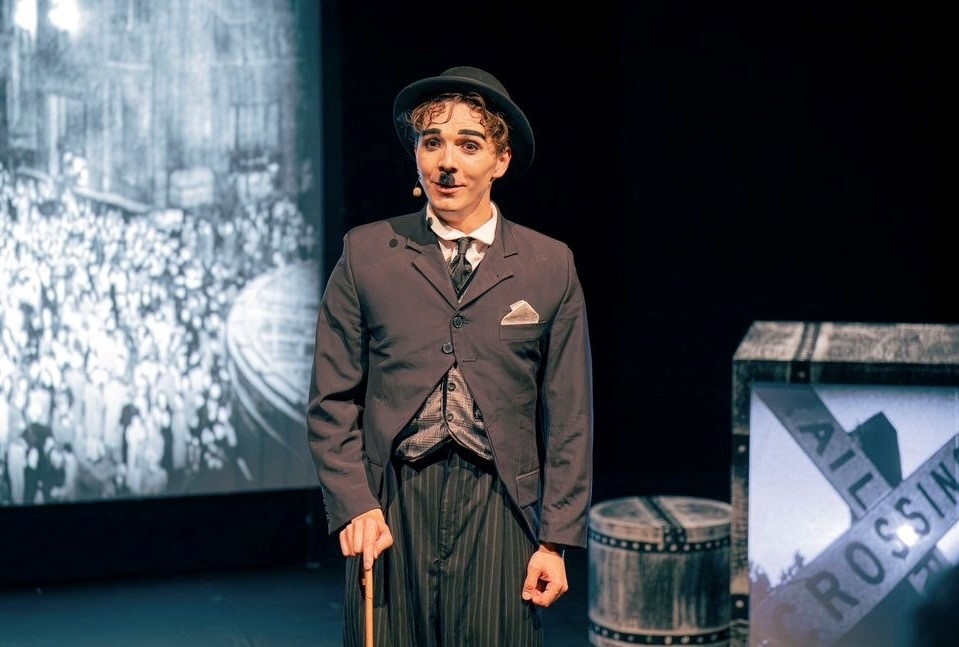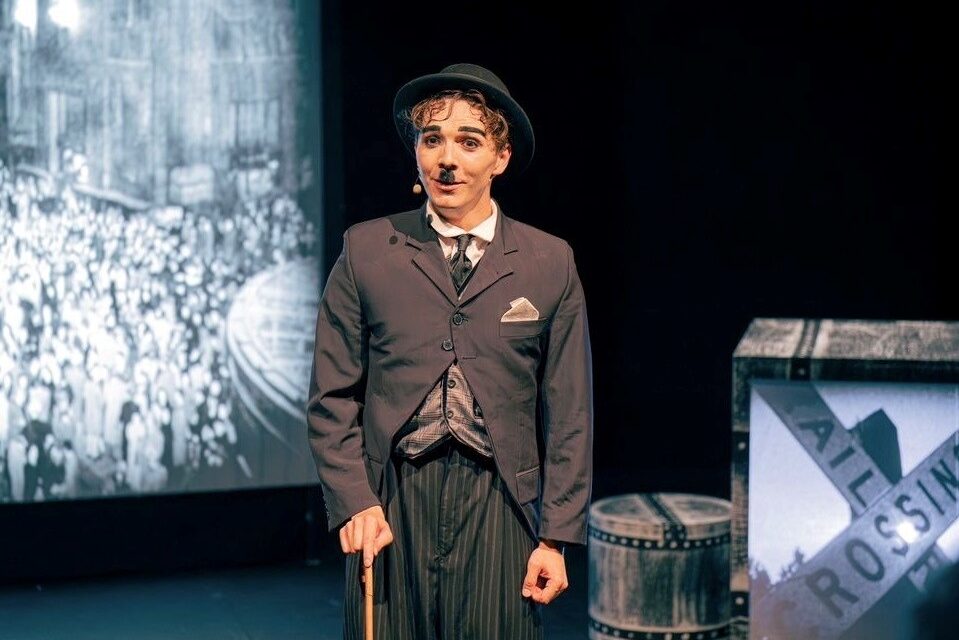| What: The Tramp – cabaret Featuring: Daniel Anderson Piano: Paul Ferreira Writer/director: Amanda Bothma Choreography: Sonwa Sakuba Lighting and set design: Wilhelm Disbergen AV Design: Andrew Timm and Adino Trapani Musical Arrangements: Paul Ferreira and Daniel Anderson Additional musical arrangements: Dale Ray and Bryan Schimmel Producer: Wêla Kapela Productions Running time: 85 mins |
I loved The Tramp so much, I saw it twice. The Cape Town October 2025 season is over but hopefully there will be an opportunity soon to see this intriguing cabaret, inspired by the brilliant Charlie Chaplin. Tour de force performance by Daniel Anderson, with Paul Ferreira at the piano, as second performer.
Consider the epic career of Charlie Chaplin. Before his 30th birthday, Chaplin was famous and rich. He was very much in control, steering his own career. Mindful of retaining full artistic and financial control of his films, in 1919, when he was 29 years old, he co-founded United Artists with A-listers Mary Pickford, Douglas Fairbanks and D. W. Griffith. The Tramp – his famous character – persona – or perhaps one could say – nemesis – or imaginary friend was cooked up in 1914, when he was 24, working at Keystone Studios in the UK. Yes, he was 24. Shortly before the birth of the Tramp aka The Little Fella, America became Chaplin’s adopted home– until he was exiled to Switzerland because of his communist sympathies.
In 2025, in South Africa, we have the gloriously talented Daniel Anderson evoking and embodying the artistic spirit of Charlie Chaplin – with his flaws and complexities peeking through. By the way, Anderson is 25– young and extremely talented – like Chaplin. Anderson learnt his skills on the theatrical/musical boards in East London. As with Chaplin, Anderson did not study at a tertiary education institute. Just saying.
Chaplin – and The Tramp’s – influence endures in multiple spheres – and includes film and direction, comedy, satire, clowning, dance. Chaplin was an auteur par excellence – literally the author of his films – writing, directing, performing and scoring most the music. I find that magical that the talented young performer, Daniel Anderson is bringing the Tramp into our orbit, in a theatre, which transcends flickering footage on YouTube.
On my first viewing, I was bowled over by Anderson’s physical evocation of The Tramp – the walk, the strut, the jerky dance routine (referencing Chaplin’s career origin story in vaudeville and clog dancing), the silent, disheveled yet heroic clown that shape shifts through situations and scenarios. It is through The Tramp’s gaze that we travel into the life and times of Charlie Chaplin. I went for a 2nd viewing so that I could get the full thrust of the narrative –which unspools through an inspired song list, screened film footage and cartoon-like graphics in light boxes. See box, below, for song list.
The production has been tagged by its producer, Wêla Kapela Productions as a cabaret and pocket musical but it goes deeper than that. It is not a docu-drama or a tribute show. It is a homage and a lament. Whilst the Tramp does foreground aspects of Charlie Chaplin’s life, it is not meant to be an linear historical rendition but it is also not fictional.
The music is mostly not period specific. The pre-performance music (while one is walking into the theatre) and music played while the bows are taken is by Scott Joplin. Joplin’s famous ragtime collection, The Entertainer has become emblematic of silent film and of course Chaplin was the maestro of silent movies. The Tramp was part of that oeuvre until he was discarded by Chaplin in the film Modern Times (1936). It was The Tramp’s exit from the big screen. It was also the first time, the world heard the voice of The Tramp, singing the Nonsense Song – Je Cherche Aprés Titine. Or was it the “voice” of Charlie Chaplin, trying to reclaim his identity? Was Charlie Chaplin muted by his own alter ego, as he got sucked into fame, wealth, celebrity and adoration of his beautiful visage?
What about Chaplin’s questionable behaviour to fellow artists, women and lovers? He was embroiled in paternity suits and controversy. He was a perfectionist but arrogant and flawed. With his objectification and treatment of women, he would have probably not stood a chance in the Me Too era but his brilliance, vision and creativity endues as a legacy for us to immerse ourselves and The Tramp – the stage show – does that.
The cabaret genre provides a gateway for contemporary and younger audiences to access Chaplin and his oeuvre, through a tapestry of songs, which Anderson teases out vocally and theatrically, the intricacies of Chaplin as an outsider as a loner. His parents were both music hall performers. His father was largely absent from his life. His mother grappled with mental health challenges. Listen to the lyrics of John Lennon’s Mother, in the Tramp: “Mother, you left me but I never left you. Oh-oh-oh, I needed you, you didn’t need me, oh no … Children, don’t do what I have done. Oh-oh-oh, I couldn’t walk, I tried to run.” Heartbreaking – we see the grief and loss in The Tramp (aka Daniel Anderson). In The Great Pretender, we get the full thrust of anguish and pain of the neglected lad suffering from imposter syndrome. In Sting’s Englishman in New York, we get a palatable ache of Chaplin never fitting in, the pathos and tragedy in his life, despite all the comedy. His life was a tragi-comedy. This is reflected in the credits of the of the film prelude, screened at the start of the show. Watch carefully.
Arrangements of the songs in The Tramp are by Paul Ferreira and Anderson, with additional musical arrangements by Dale Ray and Bryan Schimmel. Amanda Bothma – the director – has brilliantly woven strands of Chaplin/The Tramp into the script – linking stories between songs. They are prompts, to encourage us to ponder the work and legacy of Chaplin.
Bravo to Wêla Kapela Productions for developing its own distinctive take on contemporary cabaret- using modern-day songs to evoke a figure from the past a period. WK did this with Vincent van Gogh and now with The Tramp, the company has levelled up with a full theatre experience – using animation, filmic elements and knockout physical comedy. Shout outs to Paul Ferreira on piano, as second performer – for his beautiful piano – and his cognition and sense of The Tramp in the space (watch them gesture to each other); choreographer, Sonwa Sakuba, designer Wilhelm Disbergen (lighting and set) and Andrew Timm and Adino Trapani (AV design).
Mention must be made to the incredible use of The Tramp footage on the screen, from which The Tramp emerges and disappears into. For this production, they have used archival footage of the Tramp/Chaplin AND footage created, with Anderson dressed and performing as the Tramp, filmed in a studio. There are moments of intersection – between then – the past – now-ish. For example, we see The Tramp (aka Daniel Anderson) with balloons imaged in the iconic Nena anti-war song – 99 Red Balloons (beautifully arranged by Dale Ray). We see The Tramp/Daniel Anderson putting on make-up and getting ready to charm us now – in 2025. Watch carefully.
Circling back to the song list, Charlie Chaplin’s Smile was used in Modern Times (1936) – instrumentally – no lyrics. The film was Chaplin’s “love letter to silence”. He scored the music. Lyrics were added by John Turner and Geoffrey Parsons in 1954: “Smile, though your heart is aching …Smile, even though it’s breaking. When there are clouds in the sky you’ll get by. Smile and maybe tomorrow. You’ll see the sun come shining through for you…” In this fractured world, we need to embrace hope and The Tramp underscores that as a work of theatre, cabaret and entertainment. It did make me smile and made me dive into the wondrous world of Charlie Chaplin’s work. Don’t miss The Tramp.

| THE TRAMP SONG LIST – as supplied October 2025 by Wêla Kapela Productions – the before-show music and bow music (Scott Joplin) is not here and snippets of other songs are also not in this list 1. As If We Never Said Goodbye (From “Sunset Boulevard”) 2. Englishman In New York (By Sting, arr Dale Ray) 3. If My Friends Could See Me Now (From “Sweet Charity” arr Dale Ray) 4. Mother (by John Lennon) 5. No One Is Alone (From “Into The Woods”) 6. On The Street Where You Live (From “My Fair Lady”) 7. The Great Pretender (By The Platters, also made popular by Freddie Mercury, arr Bryan Schimmel) 8. A Stranger Here Myself (From Kurt Weill’s “A Touch of Venus”) 9. Je Cherche Aprés Titine – The Nonsense Song (By Maubon & Bartel) 10. Break My Heart Again (By PHINNEAS) 11. Will You Still Love Me Tomorrow? (By Carol King) 12. 99 Red Balloons (By NENA, arr Dale Ray) 13. How Did We Come To This? (From “Wild Party”) 14. Smile (by Charlie Chaplin) |
✳ Featured image – Daniel Anderson in The Tramp. Pic: Daniel Rutland Manners. Supplied.








